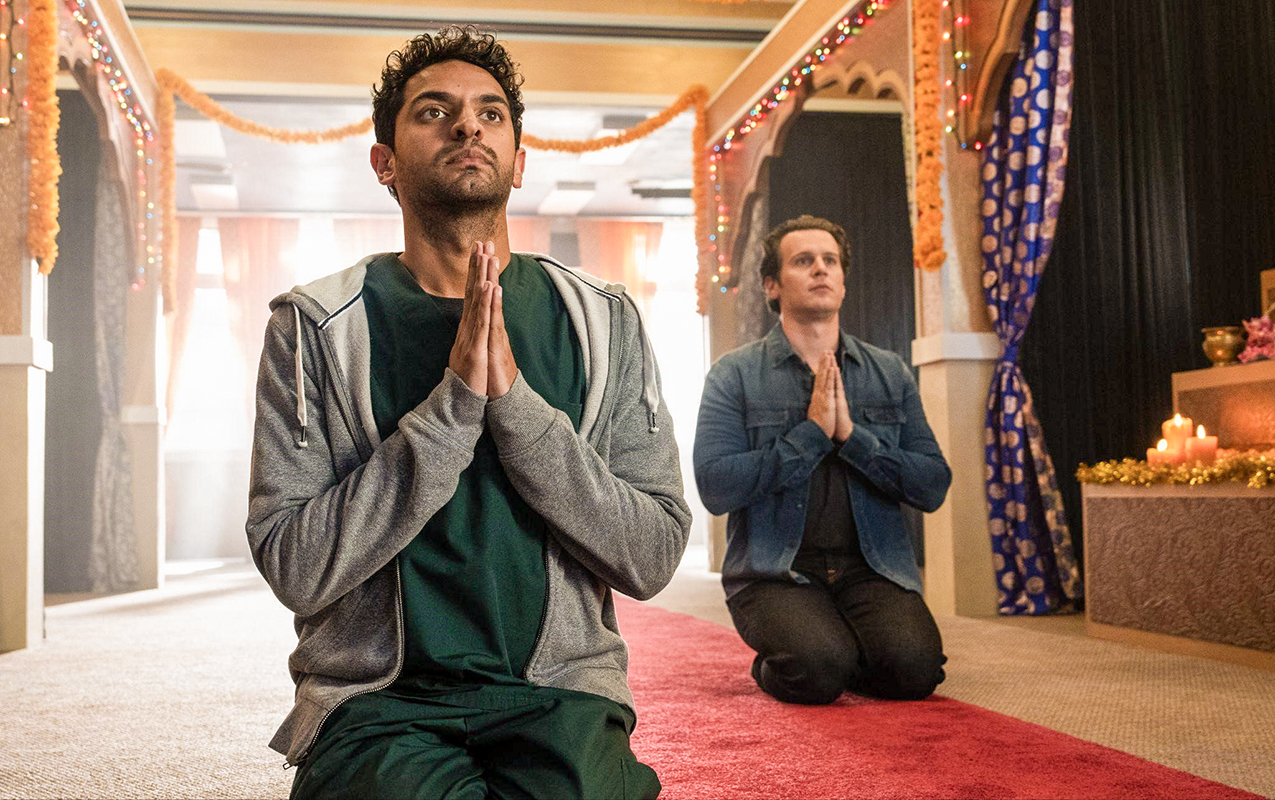Marriage Wars
In 1996, DOMA went from being introduced to being passed by the House – and given the OK of the Clinton administration – in less than 10 weeks
Part Two of a series marking the 15th anniversary of the passage of the Defense of Marriage Act
”Given your stated and longstanding opposition to gay marriage, we believe there would not be a substantive basis for you not to sign the proposed legislation if it were to be adopted by Congress,” White House counsel Jack Quinn, senior advisor to the president George Stephanopoulos and White House gay and lesbian liaison Marsha Scott wrote to President Bill Clinton on May 10, 1996 — three days after Rep. Bob Barr (R-Ga.) introduced the Defense of Marriage Act in Congress.

(Photo Illustration by Todd Franson. Original cake photo by James Steidl/iStockphoto)
”It is therefore our recommendation that you should sign this legislation if it is enacted,” the trio continued.
It would be two weeks until Clinton made his first remarks on the bill, but the interceding two weeks — if there ever was a question — sealed the fate of the bill and showed the extent to which Democrats were completely unprepared to address the issue at all, let alone present any sort of unified approach in opposition.
From a Department of Justice letter stating that there were no constitutional problems with the bill, to disputes in the House about how to oppose the bill, to a muddled White House message that resulted in conflicted and confused statements all around, the disorganized Democratic strategy allowed the Republicans to create a vigorously anti-gay record for the bill and move it successfully through the House in less than 10 weeks.
The May 10 letter was one of several about same-sex marriage directed to Clinton, Vice President Al Gore and senior White House staff that were provided to Metro Weekly as part of its review of the circumstances surrounding the consideration and passage of the 1996 law. The letters, unsurprisingly from the established history of DOMA, show a staff that appeared to dislike the bill but was attempting to find the least harmful way of addressing the legislation in light of Clinton’s opposition to same-sex unions.
At the other end of Pennsylvania Avenue, however, the House was in its second year of being run by the ”Contract with America” Republicans and House Speaker Newt Gingrich (R-Ga.). Bills like DOMA moved fast. A week after Barr introduced the bill, Rep. Charles Canady (R-Fla.) — the chairman of the Judiciary Committee’s subcommittee on the Constitution — held hearings into the bill.
Robert Raben, who served as the minority counsel for the Democrats on the subcommittee, explained the nature of the House, and particularly the Constitution subcommittee, at the time.
”[W]hen [the Republicans] took control of the legislature in January of 1995, there was a fantastic pent-up energy and demand for just a mind-boggling amount of social legislation, economic too. And a huge percentage of it … happened to go through the judiciary committees,” he says. ”So, for those of us who were literally doing the work, it wasn’t like the ban on gays in the military, which was volcanic — out of place to everything else going on that year, in terms of attention, voter turnout, angst.
”This was, ‘It’s Tuesday, so we’re banning affirmative action.’
Although Raben says DOMA was ”particularly excruciating” for him and the only openly gay House Democrats at the time – Rep. Barney Frank (D-Mass.) and Rep. Gerry Studds (D-Mass.) – the social conservative agenda was uniformly painful.
”[All] this happens in a context of vicious social regulation from the federal level from a crew of people who paid obeisance to states’ rights, who then turned around and said at the federal level, ‘Alabama wasn’t banning abortion enough. We have to do this.”’
At the time, Barr — who now opposes DOMA and supports marriage equality — and Canady saw it differently. Referring to the ongoing Hawaii case brought by several same-sex couples challenging the state’s refusal to grant them marriage licenses, Canady opened the May 15, 1996, hearing by saying, ”Should we let three judges in Hawaii decide to redefine marriage, not only for the people of Hawaii, but for the rest of the country as well?”
”The bill that we have crafted … in response to that threat is a reaction and not an overreaction,” Barr said at the 1996 hearing. “It addresses the issue in precisely the terms in which it must be addressed, and no further.” By 2009, Barr had concluded that ”DOMA’s language reflects one-way federalism,” writing in the Los Angeles Times, ”It protects only those states that don’t want to accept a same-sex marriage granted by another state.”
Barr’s position in 1996 — that the bill was a limited response to the ongoing Baehr v. Lewin same-sex marriage challenge in Hawaii — was echoed across the Republican side of the aisle. Citing a ”Winning and Keeping Equal Marriage Rights: What Will Follow Victory in Baehr v. Lewin?” memorandum written in March 1996 by Lambda Legal’s Evan Wolfson, Rep. James Sensenbrenner (R-Wisc.) said, ”The bill … does preserve the right of each state to determine its own marriage policy and not to be boot-strapped into same-sex marriages by Federal court suits because marriages were performed in Hawaii and there is a Hawaii marriage license that the couple would present [in another state].”
But it wasn’t only the Republicans who put same-sex marriage advocates on the defense in the hearing that day. As Andrew Sullivan puts it, ”The morning of [the hearing], of course, the Clinton administration kicked us in the balls by deliberately, without even telling us, coming out … and saying that they thought DOMA was constitutional. In May ’96, it was the beginning of the re-election campaign.”
Although the subtleties are disputed by others, it is true that the Department of Justice submitted a three-paragraph memorandum from DOJ Legislative Affairs Assistant Attorney General Andrew Fois dated May 14, 1996, stating that a DOJ representative had been invited to testify and announcing, ”The Department of Justice believes that H.R. 3396 would be sustained as constitutional, and that there are no legal issues raised by H.R. 3396 that necessitate an appearance by a representative of the Department.”
Richard Socarides — who was the Labor Department’s White House liaison before moving, in the midst of DOMA’s consideration, to the role of White House gay and lesbian liaison — says of the DOJ’s statement, ”That was a very unfortunate moment.” He doesn’t, however, fault the White House for the letter. ”We were not in the position to influence the Justice Department’s position [on DOMA.] The Justice Department operates independently, and they were — as far as I could tell at the time — acting independently in that regard.”
The DOJ letter was not the only unfortunate moment for the administration at the time. In the days before the hearing, the White House was having its own issues — from White House spokesman Mike McCurry.
In the trio’s May 10 letter — which has multiple notations that it was seen by the president — Quinn, Stephanopoulos and Scott detailed a plan for addressing DOMA.
”[W]e recommend that in the first instance, the White House should state that you are opposed to gay marriage, but that there has not yet been an opportunity to review this legislation. … If and when this approach is no longer viable, the White House would state that you would be prepared to sign this bill if enacted by Congress.”
The reason for this approach, they wrote, was because ”there is a risk that too early an announcement of a willingness to sign the bill could cause Republicans to add even more draconian provisions.”
Three days later, on May 13, McCurry was asked repeatedly about the president’s position on marriage and the legislation. Although he initially kept to the May 10 plan, he at one point responded to a follow-up question asking why Clinton opposed same-sex marriage by saying that ”He believes this is a time when we need to do things to strengthen the American family, and that’s the reason why he’s taken this position.”
Paul Yandura, working in the White House gay and lesbian liaison’s office at the time, said of the moment, ”McCurry spoke out and spoke about the president’s stand on marriage and opened it up. And that caused a shitstorm.”
The Human Rights Campaign expressed serious concern with McCurry’s language, and McCurry clarified the remarks in the next day’s briefing. ”The President believes that marriage as an institution ought to be reserved for a union between one man and one woman,” he said. “That’s his view – has long been his view. I haven’t gone deeper into the moral philosophy behind it.” Despite that claim, a memo from Quinn to Clinton dated April 8, 1996, shows that the specific language so opposed by HRC had been seen and approved by Clinton, who checked ”Agree” on the memo’s suggested language: ”[T]he institutions of traditional marriage and family face tremendous pressures in today’s society. We must do everything we can to support and strengthen these institutions.”
The White House continued to struggle with its approach on the issue in the weeks following the hearing, with McCurry saying on May 22 that Clinton would sign the bill if passed as introduced. The next day, however, Clinton, in stating that he was willing to sign the bill, described ”the only legal effect of the bill” as being Section 2’s interstate recognition provision – without mentioning Section 3’s federal definition of marriage – which required later clarification from the White House.
But the House kept moving forward, with the subcommittee marking up and passing the bill out of the subcommittee on May 30 and the full committee voting on June 12 on a 20-10 vote (with five members not voting) to report the bill to the floor. Democratic amendments aimed at stopping or diminishing the impact of the bill were rejected, including an amendment offered by Frank that was rejected on a 13-19 vote to strike the definition of ”marriage” and ”spouse” from the bill.
Raben — calling the debate ”raw nastiness” — points to another rejected amendment as the ”saddest” part of the mark-up. The amendment, he says, ”would have carved out from the federal definition a state which had enacted a definition by referenda or initiative. The whole argument was these judges were going to impose this. … ‘What if the state of Iowa had a referenda and they determined that marriage was gender neutral, by referenda?’ No. That went down.” The vote was 8-14 rejecting that one.
On July 9, with any possibility of White House or Justice Department opposition out of the way, Canady submitted the report on DOMA. Detailing that ”[s]ome in our society … are not satisfied that marriage should be an exclusively heterosexual institution,” the committee report lays out the case against same-sex marriage in religious, moral and explicitly anti-gay terms unlike the plain language of the bill itself.
In discussing the ”government interests advanced by” DOMA, the report states, ”the Committee does not believe that passivity is an appropriate or responsible reaction to the orchestrated legal campaign by homosexual groups to redefine the institution of marriage through the judicial process.
”[B]ecause America … is concerned about its children, our government has a special obligation to ensure that we preserve and protect the institution of marriage,” the report noted, adding later, ”Civil laws that permit only heterosexual marriage reflect and honor a collective moral judgment about human sexuality” — ”judgments” that the report called ”inevitable and entirely appropriate.”
Nine of the Democrats on the committee submitted their dissenting views to the report, calling the law ”unsupportable” and making the legal and moral case against it: ”The notion that allowing two people who are in love to become legally responsible to and for each other threatens heterosexual marriage is without factual basis.”
On July 12, 1996, the House voted with the majority of the committee. With only 65 Democrats and then-Rep. Bernie Sanders (I-Vt.) and out gay Rep. Steve Gunderson (R-Wisc.), in opposition, 342 members of the U.S. House of Representatives — 224 Republicans and 118 Democrats — voted to pass the Defense of Marriage Act.
This is the second of a series marking the 15th anniversary of the passage of the Defense of Marriage Act. The aim of the series is to present an in-depth examination of the circumstances, consideration and passage of the 1996 federal marriage law.

Part 1: Domestic Disturbance
Before DOMA, there was another debate over marriage – within the gay and lesbian community
Part 2: Marriage Wars
In 1996, DOMA went from being introduced to being passed by the House – and given the OK of the Clinton administration – in less than 10 weeks
Part 3: Double Defeat
In 1996, ENDA was hoped to help ease the pain of DOMA, but instead fell by one vote in a Senate focused on a ”thinly disguised example of intolerance”
Part 4: Becoming Law
On Sept. 21, 1996, President Clinton signed DOMA into law – a turning point for the marriage debate that left a mark of discrimination still on the books
Support Metro Weekly’s Journalism
These are challenging times for news organizations. And yet it’s crucial we stay active and provide vital resources and information to both our local readers and the world. So won’t you please take a moment and consider supporting Metro Weekly with a membership? For as little as $5 a month, you can help ensure Metro Weekly magazine and MetroWeekly.com remain free, viable resources as we provide the best, most diverse, culturally-resonant LGBTQ coverage in both the D.C. region and around the world. Memberships come with exclusive perks and discounts, your own personal digital delivery of each week’s magazine (and an archive), access to our Member's Lounge when it launches this fall, and exclusive members-only items like Metro Weekly Membership Mugs and Tote Bags! Check out all our membership levels here and please join us today!






















